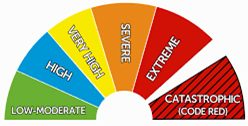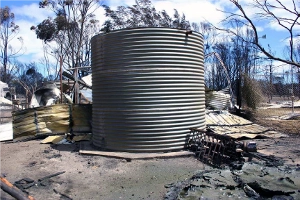Bushfire Water Tank Requirements
Climate change experts are predicting an increase in the number and intensity of bushfires across Australia in the next few years. As a result of the intense bush fires across Australia in the last few years, all States have developed a set of requirements and guidelines for the storage of water in different locations.
Bushfire Prone Land
The NSW Rural Fire Service (NSW RFS) has defined bush fire prone land (BFPL) as land identified by the local council which can support a bush fire or is subject to bush fire attack. They have developed bush fire prone land maps and resources such as:
- Building in Bush Fire Prone Areas
- Water Supply for Fire Fighting Purposes
In Queensland, the Queensland Fire Emergency Service (QFES) uses the terms Bush Fire Hazard Area (BFHA) interchangeably with Bush Fire Prone Areas (BFPA) and have produced different shapefiles for 13 different regions across Queensland. For example:
- Bushfire Prone Area – Wide Bay Burnett Spatial Data Format
Fire Danger Rating
A common feature of the requirements is the Bushfire Attack Levels (BALs) which were developed to help State and National Governments indicate to property owners and builders the different requirements for each of the different levels of bushfire risk. The six BALs based on radiant heat flux exposure threshold are as follows.
- BAL-LOW
- BAL-12.5
- BAL-19
- BAL-29
- BAL-40 and
- BAL-FZ

Fire Danger Rating
Each State has different requirements and Guidelines. These could include:
- The water storage requirements depending on property size and the type of development (see Building in Bushfire Prone Areas )
- TA dedicated bushfire water tank
- TA combination water tank fitted for both bush fire and home purposes
- Appropriate access by the local Fire Service
- Appropriate signage
- A bushfire Plan which includes essential requirements if you decide to stay rather than go during a bushfire
- A bushfire Survival Kit which should include things such as:
- ladder, shovel, mop, bucket, hose, fire extinguisher, knapsack sprayer, first aid kit, medications and scripts, towels, blankets, safety goggles, masks, gloves, bottled water, battery radio, and batteries
Access to stored water is vital in a bushfire prone area because the local water supply might get cut off and you will need:
- Access to water to put out spot fires
- Access to a sprinkler system to keep the radiant heat down
- To provide access to water by the local fire service
Setting Up Water Tanks in Bushfire Prone Areas
There are a range of factors to consider when setting up a water tank in a bushfire prone area. For example:
- Building in Bush Fire Prone Areas
- You will need a metal tank which will keep its structural integrity during a fire.
- Do you want a stainless steel tank which is by far the safest and even more robust than an aquaplate/colorbond one?
- There needs to be a clear space around the tanks site so that there is nothing that could burn and so that the local fire service truck can get good access to the tank outlet.
- Your draw-off outlet needs to be fitted with the correct hose connections to connect to the local fire service appliances. Each State has a different fitting. For example, a Storz fitting is needed in NSW and a Camlock fitting in Qld.
- Exposed PVC pipes and fitting will melt in a fire so make sure your valves and pipe fittings are made from metal to ensure they can withstand high temperatures.
- Do not rely on an electric pump as power will most likely be cut off during a bush fire. It is best to have a diesel or petrol driven pump and your generator needs more than 1,5kVa capacity to drive the pump.
- The generator and pump should be able to pump a minimum of 400 litres per minute and must be built with shielding from high temperatures.
- You can install a dedicated water tank for firefighting purposes only or you could install a combination water tank where water can be stored for both firefighting and domestic use.
- A minimum of 10,000 litres need to be available for firefighting purposes so combination tanks usually store more than 20,000 litres of water.
- Check with the water storage requirements for your area depending on the type of property and the size of your property. See Building in a bushfire Area on the NSW RFS Website www.rfs.nsw.gov.au or one of the 13 different regional data sheets produced by the Queensland Fire and Emergency Services. www.qfes.gld.gov.au
Water Tanks for Bushfire Protection
Water tanks made from metal are extremely durable because they keep their structural integrity during a bushfire. Stainless steel tanks in particular, have proven to withstand intense heat remarkably well. They also can be configured to reserve an amount of water (say 10,000 litres) for access by the rural fire brigade during a bushfire while the remaining water can still be available for regular local use.
Researchers from the CSIRO and Monash University have conducted extensive testing on the performance of water tanks in bush fires. They found:
Stainless Steel Tanks did not burn or split when fully exposed to fire for over 30 minutes. They became slightly scorched but there was no structural damage and only minor water loss.
For more information see: www.bushfirecrc.com
Aquaplate (Colorbond) Tanks maintained structural integrity in a fire but when the temperature reached above 65 degrees, the thin plastic lining on the inside of the tank began to delaminate, causing slight water loss.
Polyethelene (plastic) Tanks quickly split and collapsed in a fire, emptying themselves and melting down.
Local Council Regulations
Most Councils in fire prone areas have developed a set of regulations for property owners to manage bushfire risks in these areas. For example:
- Installing a metal tank
- Minimum of 10,000 litres reserved capacity for fire-fighting purpose
- Special fittings need to be installed so the Rural Fire Service can fit their appliance to your tank
Please check the Council regulations for your area.
Rainwater Quality in Bushfire-prone Areas
If like many people in Australia you live in bushfire-prone areas and also happen to depend on the rainwater harvested from your roof(s) for essential living or to supplement you local municipal water supply.
Rainwater quality can become problematic as bushfires can produce large amounts of smoke, ash and other debris which can land on the roof and contaminate the rainwater being collected. Fire retardant material and fire-fighting foaming agents can also end up on the roofs and interfere with the quality of the rainwater being harvested.
Steps to Avoid Pollution of your Harvested Rainwater
- ,”Make sure when installing the system of pipes from the guttering to the inlet on the top of the water tank that somewhere along the system, the pipes can be quickly and easily disconnected. There are a variety of leaf collection devices that could easily serve such a purpose. This prevents any material from a bushfire that has been deposited on the roof, from getting its way into the water tank and causing the water stored in the tank to be contaminated.
- As soon as there is a threat of a bushfire, dismantle the pipe(s) connected to the water tank, to prevent windblown debris and contaminants from entering the tank. If possible. It may also be best to cover the inlet and overflow fittings so that no debris gets blown into the water tank through those openings.
- After the bushfire, disconnect the pipes to the tank if you didn’t get a chance to do so before the fire.
- Use gloves to remove any debris from the roof or guttering or pipes and set about cleaning the roof. This probably means scrubbing the roof to remove resistant residues and/or contaminants. Use clean water to do this process. Using a very mild detergent may be needed but it is not recommended because if a small amount of detergent gets into water tank, then it is very very difficult to completely remove from the water in the tank. You will need to call a professional tank cleaning service if you think the water inside the tank is contaminated in any way. Ensure you take appropriate safety measures when working on the roof and gutters.
- Clean the gutters and the pipes and reconnect the pipes between the gutters and the tank and if you have a first flush device, ensure it is empty and in working order.
- The water used to flush out the debris and residue should be redirected to a place where is won’t cause any major harm or damage to the environment and the water won’t build up and become a mosquito-breeding pond.
- If it rains after the bushfire and before any disconnection and cleaning is done, then it is likely that contaminated water has already entered the tank. If this is the case then the tank will need to be emptied and cleaned and fresh clean water will need to be used to start filling the tank again.
- Check that the bushfire has not damaged the structural integrity of the metal tank. This sometimes can happen along a seam above the water line in the tank. If the structural integrity of the tank has been compromised, then you need to organize for the tank to be emptied and repaired.



